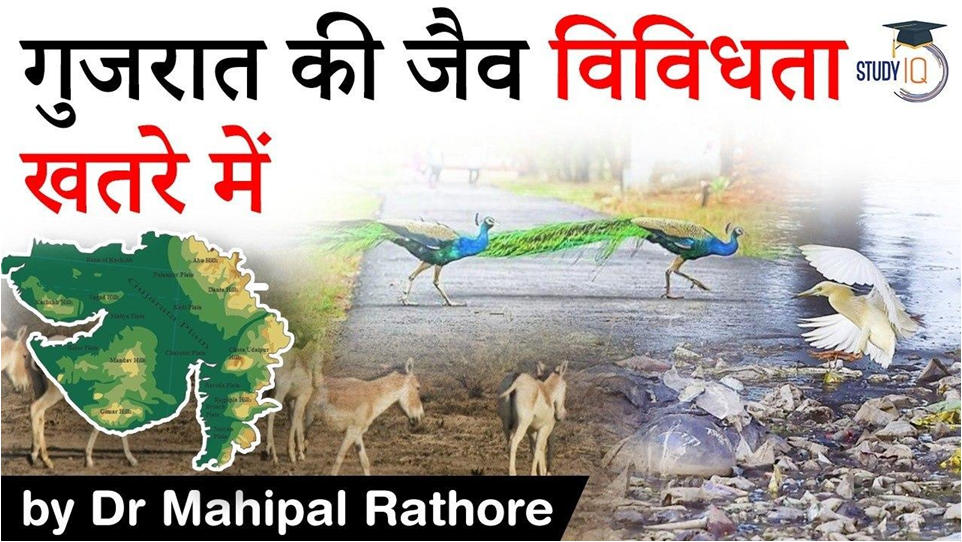Table of Contents
Q) Which beach situated in the state of Gujarat has been given the Blue Flag certification?
- Ghoghla
- Kasarkod
- Padubidri
- Shivrajpur
Gujarat
- Gujarat’s ecology houses extremely rare, endemic wildlife like the lions, hyenas, wolves, wild ass and birds like the great Indian bustard and the lesser florican.
- Conservation of scattered and isolated pockets of wildlife is important
Varied Climate and Vegetation
- Gujarat has vast stretches of grasslands, dry and arid zones, salt marshes and scrub forests, and the longest coastline in peninsular India.
- It harbours the northernmost tip of the Western Ghats – the Dang forests.
- Along with Dang and Gir, the Rann of Kutch and Velavadar are few isolated pockets of unique wildlife habitats that require urgent attention.
- Mangroves
- Deciduous Forests
- Moist deciduous forests – Western Ghats
- Thorn Scrub forest
- Salt Marshes

- Kachchh desert WLS
- Wild Ass WLS -LRK
- Dang – Vansda NP
- Blackbuck NP – Velavadar
- Marine National Park – Gulf of Kachchh
Little Rann of Kachchh
- Salt marshes spread across thousands of square kilometres
- Great Indian bustard
- Asiatic wild ass (Khur) – endemic
- The LRK, which is spread over 5000 square kilometres, is witnessing a spill over of the wild ass outside the protected area. As a result, this equid species has been recorded in around 15000 square kilometres across six districts of Gujarat.
- Diseases in Wild ass – population has dwindled before
- 6000 wild asses – conflict with Local domestic herds for grazing land

- Even the vast landscape of LRK is witnessing various development, anthropological and ecological pressures.
- Salt pans and Sand mining
- Pesticide and fertiliser laden FARM RUNOFF – wildlife drinks this water.
- Foreign species – juliflora
- Roads – Off roading
- Tourist resorts
- Kachchh desert WLS
- Wild Ass WLS -LRK
- Dang – Vansda NP
- Blackbuck NP – Velavadar
Velavadar Grasslands
- Small and isolated pocket of grassland
- 36 sq km – Blackbuck National Park.
- Erstwhile Hunting grounds of Bhavnagar kings
- The lesser florican
- Hyenas
- Wolves
- Blackbucks
- Changing farming pattern – Millets to Cotton – NOT SUITABLE FOR BIRDS
- Anthropogenic pressures from agricultural activities in surrounding villages and flooding due to the proliferation of salt pans nearby pose a great threat to the grasslands
- Kachchh desert WLS
- Wild Ass WLS -LRK
- Dang – Vansda NP
- Blackbuck NP – Velavadar
Western Ghats
- Vansda national park, spread over 24sq km
- Dhole – Wild dog
- Witnessed after 50 years
- Threat –
- Hunting
- Overgrazing
- agriculture
- habitat destruction
Marine Wildlife
- Marine National Park is home to the whale shark, dugong, green sea turtle, olive ridley turtle and leatherback sea turtle.
- The status of corals and numerous other sea creatures remains deplorable due to the development of industries, oil pipelines, and seaports, further depleting the mangrove cover and causing coastline erosion.

- 43 % of Gujarat’s protected reserves are less than 60 sq km
- Local extinction of a species cannot be ruled out if proper steps are not taken towards the management of the landscapes where these species thrive.
- Moreover, as far as grasslands and salt flats are treated as wastelands, it will inevitably go into the hands of industrialisation and development.
What can be done?
- Establish viable wildlife populations elsewhere in the wild, inside the historical range of the species.
- This would release pressures from isolated populations
- Grasslands and salt marshes as separate wildlife habitat – plantations shouldn’t be allowed there.
Latest Burning Issues | Free PDF























 WhatsApp
WhatsApp